Презентация global market 1



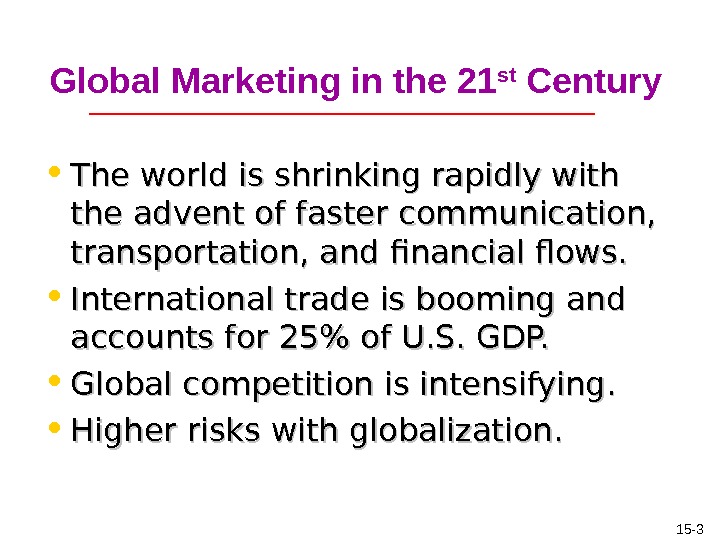
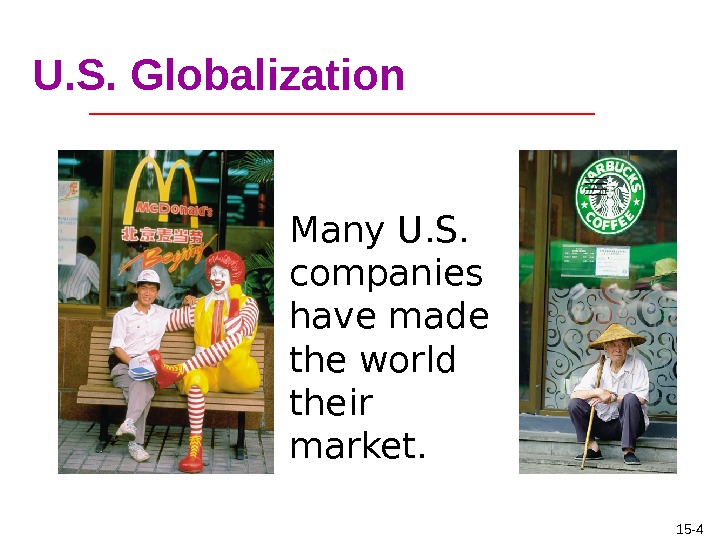
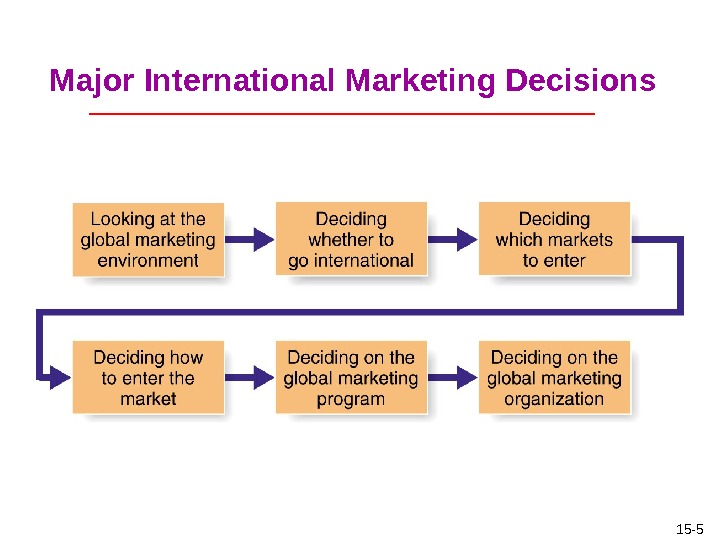
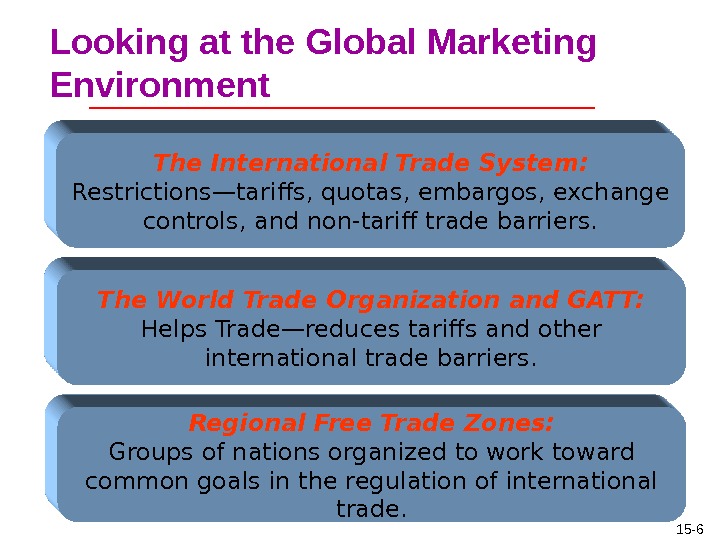

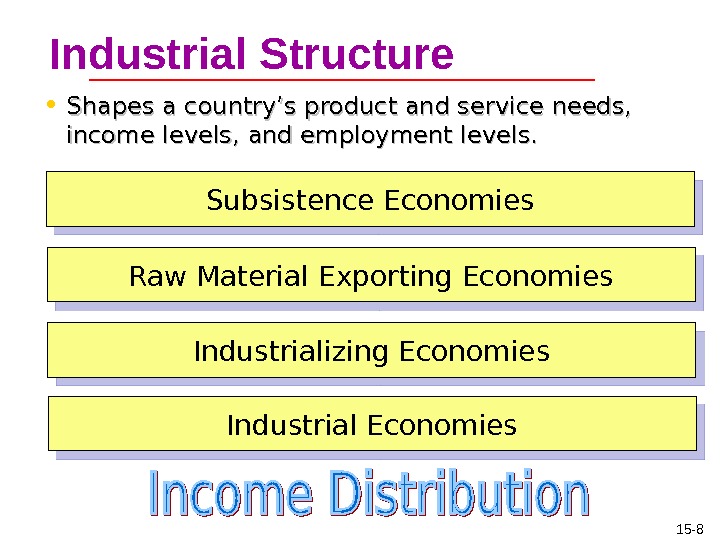
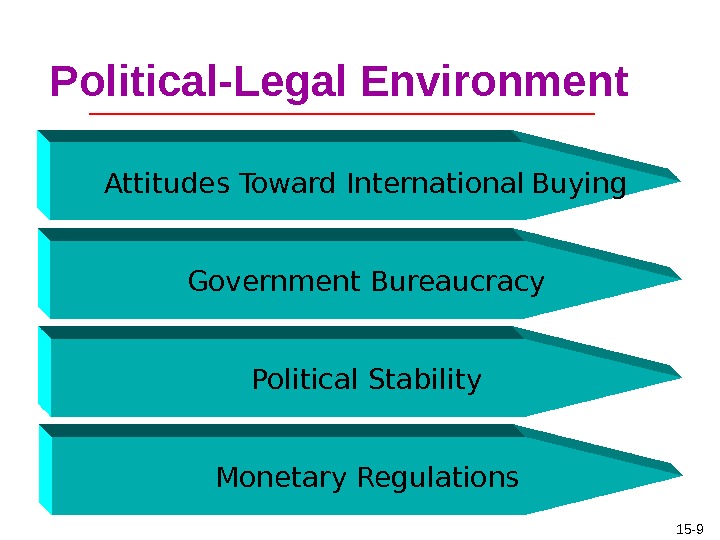
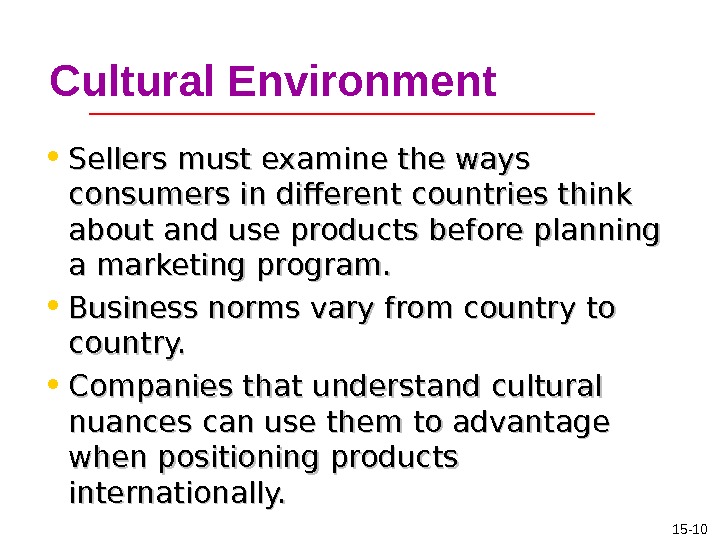


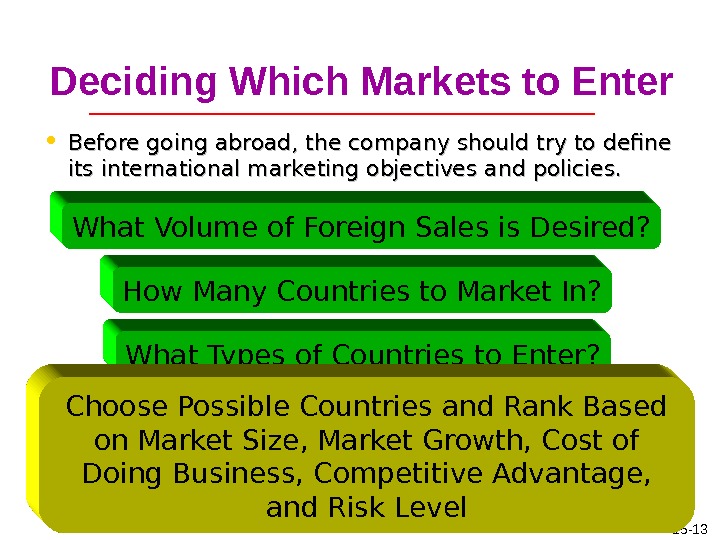



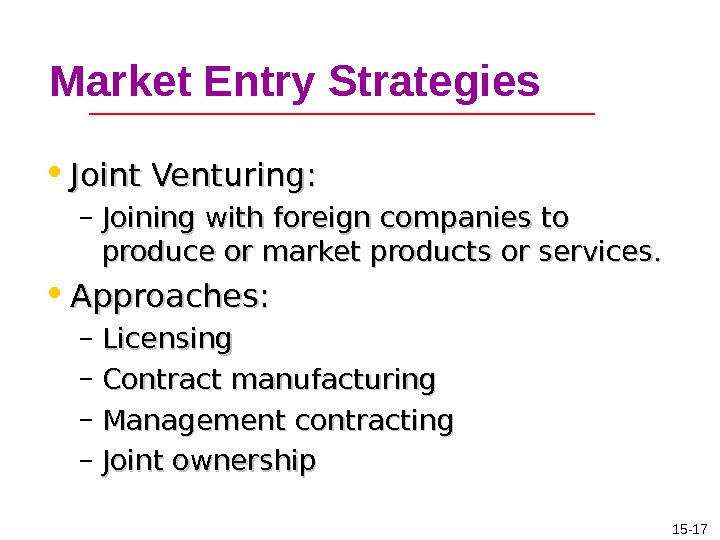

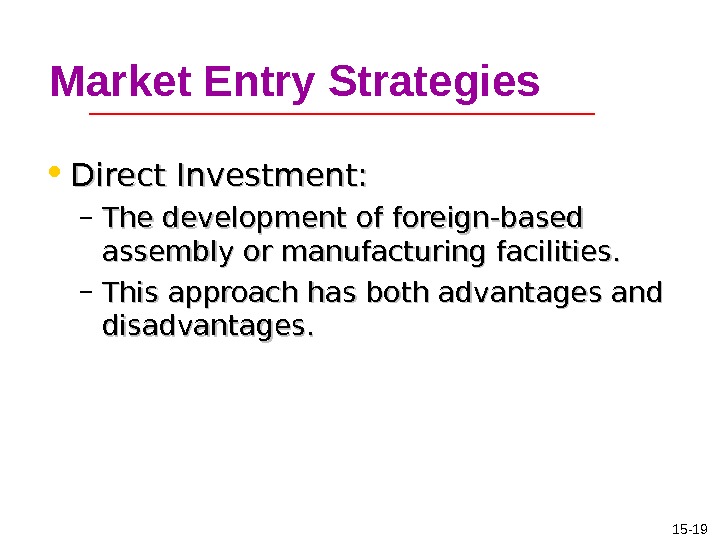




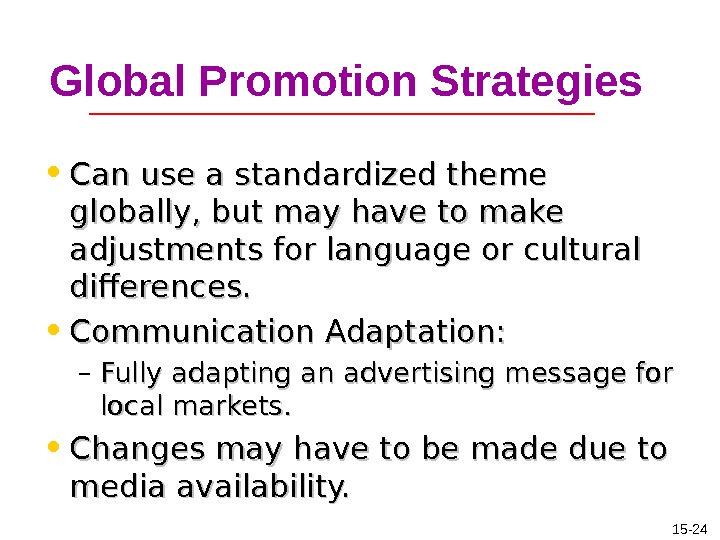

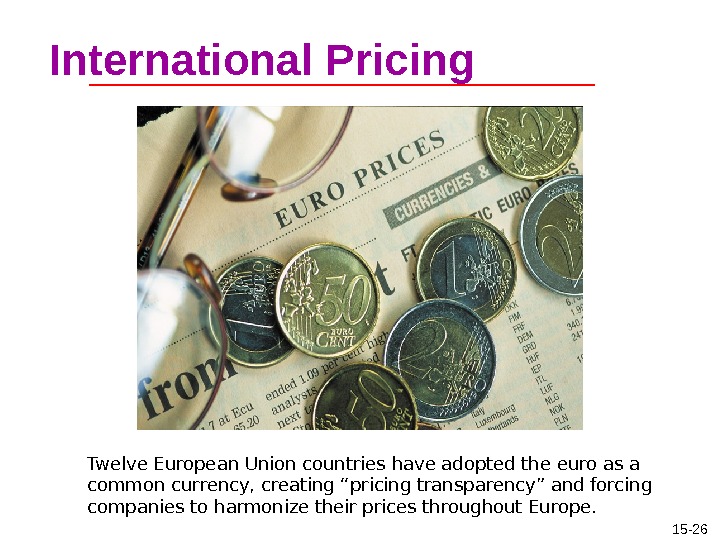
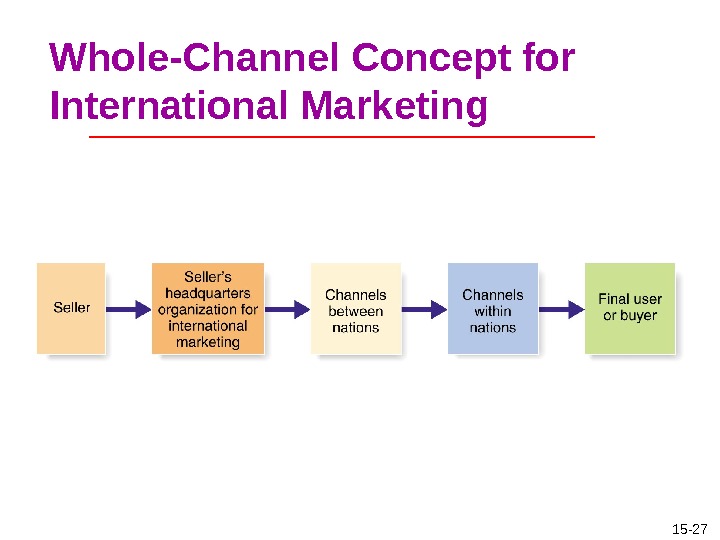
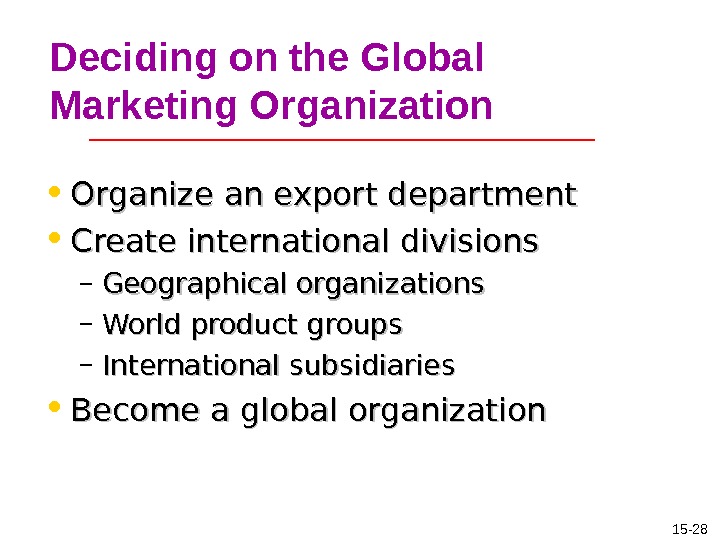

- Размер: 3.8 Mегабайта
- Количество слайдов: 29
Описание презентации Презентация global market 1 по слайдам
 15 —
15 —
 15 — 2 ROAD MAP: Previewing the Concepts • Discuss how the international trade system, economic, political-legal, and cultural environments affect a company’s international marketing decisions. • Describe three key approaches to entering international markets. • Explain how companies adapt their marketing mixes for international markets. • Identify the three major forms of international marketing organization.
15 — 2 ROAD MAP: Previewing the Concepts • Discuss how the international trade system, economic, political-legal, and cultural environments affect a company’s international marketing decisions. • Describe three key approaches to entering international markets. • Explain how companies adapt their marketing mixes for international markets. • Identify the three major forms of international marketing organization.
 15 — 3 Global Marketing in the 21 st Century • The world is shrinking rapidly with the advent of faster communication, transportation, and financial flows. • International trade is booming and accounts for 25% of U. S. GDP. • Global competition is intensifying. • Higher risks with globalization.
15 — 3 Global Marketing in the 21 st Century • The world is shrinking rapidly with the advent of faster communication, transportation, and financial flows. • International trade is booming and accounts for 25% of U. S. GDP. • Global competition is intensifying. • Higher risks with globalization.
 15 — 4 U. S. Globalization Many U. S. companies have made the world their market.
15 — 4 U. S. Globalization Many U. S. companies have made the world their market.
 15 — 5 Major International Marketing Decisions
15 — 5 Major International Marketing Decisions
 15 — 6 Looking at the Global Marketing Environment The International Trade System: Restrictions—tariffs, quotas, embargos, exchange controls, and non-tariff trade barriers. The World Trade Organization and GATT: Helps Trade—reduces tariffs and other international trade barriers. Regional Free Trade Zones: Groups of nations organized to work toward common goals in the regulation of international trade.
15 — 6 Looking at the Global Marketing Environment The International Trade System: Restrictions—tariffs, quotas, embargos, exchange controls, and non-tariff trade barriers. The World Trade Organization and GATT: Helps Trade—reduces tariffs and other international trade barriers. Regional Free Trade Zones: Groups of nations organized to work toward common goals in the regulation of international trade.
 15 — 7 • What types of U. S. companies would like to see higher tariffs and what types would like to see lower tariffs or no tariffs? Why is this the case? Discussion Question
15 — 7 • What types of U. S. companies would like to see higher tariffs and what types would like to see lower tariffs or no tariffs? Why is this the case? Discussion Question
 15 — 8 Industrial Structure • Shapes a country’s product and service needs, income levels, and employment levels. Subsistence Economies Raw Material Exporting Economies Industrializing Economies Industrial Economies
15 — 8 Industrial Structure • Shapes a country’s product and service needs, income levels, and employment levels. Subsistence Economies Raw Material Exporting Economies Industrializing Economies Industrial Economies
 15 — 9 Political-Legal Environment Attitudes Toward International Buying Government Bureaucracy Political Stability Monetary Regulations
15 — 9 Political-Legal Environment Attitudes Toward International Buying Government Bureaucracy Political Stability Monetary Regulations
 15 — 10 Cultural Environment • Sellers must examine the ways consumers in different countries think about and use products before planning a marketing program. • Business norms vary from country to country. • Companies that understand cultural nuances can use them to advantage when positioning products internationally.
15 — 10 Cultural Environment • Sellers must examine the ways consumers in different countries think about and use products before planning a marketing program. • Business norms vary from country to country. • Companies that understand cultural nuances can use them to advantage when positioning products internationally.
 15 — 11 Cultural Differences When Nike learned that this stylized “Air” logo resembled “Allah” in Arabic script, it apologized and pulled the shoes from distribution.
15 — 11 Cultural Differences When Nike learned that this stylized “Air” logo resembled “Allah” in Arabic script, it apologized and pulled the shoes from distribution.
 15 — 12 Deciding Whether to Go Global • Reasons to consider going global: – Foreign attacks on domestic markets – Foreign markets with higher profit opportunities – Stagnant or shrinking domestic markets – Need larger customer base to achieve economies of scale – Reduce dependency on single market – Follow customers who are expanding
15 — 12 Deciding Whether to Go Global • Reasons to consider going global: – Foreign attacks on domestic markets – Foreign markets with higher profit opportunities – Stagnant or shrinking domestic markets – Need larger customer base to achieve economies of scale – Reduce dependency on single market – Follow customers who are expanding
 15 — 13 Deciding Which Markets to Enter • Before going abroad, the company should try to define its international marketing objectives and policies. What Volume of Foreign Sales is Desired? How Many Countries to Market In? What Types of Countries to Enter? Choose Possible Countries and Rank Based on Market Size, Market Growth, Cost of Doing Business, Competitive Advantage, and Risk Level
15 — 13 Deciding Which Markets to Enter • Before going abroad, the company should try to define its international marketing objectives and policies. What Volume of Foreign Sales is Desired? How Many Countries to Market In? What Types of Countries to Enter? Choose Possible Countries and Rank Based on Market Size, Market Growth, Cost of Doing Business, Competitive Advantage, and Risk Level
 15 — 14 Colgate Goes to China Using aggressive promotional and educational programs, Colgate has expanded its market share from 7% to 35% in less than a decade.
15 — 14 Colgate Goes to China Using aggressive promotional and educational programs, Colgate has expanded its market share from 7% to 35% in less than a decade.
 15 — 15 Market Entry Strategies
15 — 15 Market Entry Strategies
 15 — 16 Market Entry Strategies • Exporting: – Indirect: working through independent international marketing intermediaries. – Direct: company handles its own exports.
15 — 16 Market Entry Strategies • Exporting: – Indirect: working through independent international marketing intermediaries. – Direct: company handles its own exports.
 15 — 17 Market Entry Strategies • Joint Venturing: – Joining with foreign companies to produce or market products or services. • Approaches: – Licensing – Contract manufacturing – Management contracting – Joint ownership
15 — 17 Market Entry Strategies • Joint Venturing: – Joining with foreign companies to produce or market products or services. • Approaches: – Licensing – Contract manufacturing – Management contracting – Joint ownership
 15 — 18 Joint Ownership KFC entered Japan through a joint ownership venture with Japanese conglomerate Mitsubishi.
15 — 18 Joint Ownership KFC entered Japan through a joint ownership venture with Japanese conglomerate Mitsubishi.
 15 — 19 Market Entry Strategies • Direct Investment: – The development of foreign-based assembly or manufacturing facilities. – This approach has both advantages and disadvantages.
15 — 19 Market Entry Strategies • Direct Investment: – The development of foreign-based assembly or manufacturing facilities. – This approach has both advantages and disadvantages.
 15 — 20 Deciding on the Global Marketing Program • Standardized Marketing Mix: – Selling largely the same products and using the same marketing approaches worldwide. • Adapted Marketing Mix: – Producer adjusts the marketing mix elements to each target market, bearing more costs but hoping for a larger market share and return.
15 — 20 Deciding on the Global Marketing Program • Standardized Marketing Mix: – Selling largely the same products and using the same marketing approaches worldwide. • Adapted Marketing Mix: – Producer adjusts the marketing mix elements to each target market, bearing more costs but hoping for a larger market share and return.
 15 — 21 Marketing Mix Adaptation In India, Mc. Donald’s serves chicken, fish, and vegetable burgers, and the Maharaja Mac—two all-mutton patties, special sauce, lettuce, cheese, pickles, onions, on a sesame-seed bun.
15 — 21 Marketing Mix Adaptation In India, Mc. Donald’s serves chicken, fish, and vegetable burgers, and the Maharaja Mac—two all-mutton patties, special sauce, lettuce, cheese, pickles, onions, on a sesame-seed bun.
 15 — 22 Five Global Product and Promotion Strategies
15 — 22 Five Global Product and Promotion Strategies
 15 — 23 Global Product Strategies • Straight Product Extension: – Marketing a product in a foreign market without any change. • Product Adaptation: – Adapting a product to meet local conditions or wants in foreign markets. • Product Invention: – Creating new products or services for foreign markets.
15 — 23 Global Product Strategies • Straight Product Extension: – Marketing a product in a foreign market without any change. • Product Adaptation: – Adapting a product to meet local conditions or wants in foreign markets. • Product Invention: – Creating new products or services for foreign markets.
 15 — 24 Global Promotion Strategies • Can use a standardized theme globally, but may have to make adjustments for language or cultural differences. • Communication Adaptation: – Fully adapting an advertising message for local markets. • Changes may have to be made due to media availability.
15 — 24 Global Promotion Strategies • Can use a standardized theme globally, but may have to make adjustments for language or cultural differences. • Communication Adaptation: – Fully adapting an advertising message for local markets. • Changes may have to be made due to media availability.
 15 — 25 Global Pricing Strategies • Companies face many problems in setting their international prices. • Possible approaches include: – Charge a uniform price all around the world. – Charge what consumers in each country will pay. – Use a standard markup of costs everywhere. • International prices tend to be higher than domestic prices because of price escalation. . • Companies may become guilty of dumping –a –a foreign subsidiary charges less than its costs or less than it charges in its home market.
15 — 25 Global Pricing Strategies • Companies face many problems in setting their international prices. • Possible approaches include: – Charge a uniform price all around the world. – Charge what consumers in each country will pay. – Use a standard markup of costs everywhere. • International prices tend to be higher than domestic prices because of price escalation. . • Companies may become guilty of dumping –a –a foreign subsidiary charges less than its costs or less than it charges in its home market.
 15 — 26 International Pricing Twelve European Union countries have adopted the euro as a common currency, creating “pricing transparency” and forcing companies to harmonize their prices throughout Europe.
15 — 26 International Pricing Twelve European Union countries have adopted the euro as a common currency, creating “pricing transparency” and forcing companies to harmonize their prices throughout Europe.
 15 — 27 Whole-Channel Concept for International Marketing
15 — 27 Whole-Channel Concept for International Marketing
 15 — 28 Deciding on the Global Marketing Organization • Organize an export department • Create international divisions – Geographical organizations – World product groups – International subsidiaries • Become a global organization
15 — 28 Deciding on the Global Marketing Organization • Organize an export department • Create international divisions – Geographical organizations – World product groups – International subsidiaries • Become a global organization
 15 — 29 Rest Stop: Reviewing the Concepts 1. 1. Discuss how the international trade system, economic, political-legal, and cultural environments affect a company’s international marketing decisions. 2. 2. Describe three key approaches to entering international markets. 3. 3. Explain how companies adapt their marketing mixes for international markets. 4. 4. Identify the three major forms of international marketing organization.
15 — 29 Rest Stop: Reviewing the Concepts 1. 1. Discuss how the international trade system, economic, political-legal, and cultural environments affect a company’s international marketing decisions. 2. 2. Describe three key approaches to entering international markets. 3. 3. Explain how companies adapt their marketing mixes for international markets. 4. 4. Identify the three major forms of international marketing organization.

